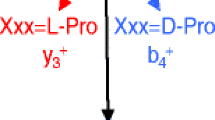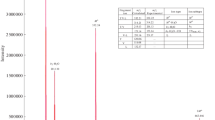Abstract
Collisionally activated decomposition (CAD) of a protonated cyclic peptide produces a superposition spectrum consisting of fragments produced following random ring opening of the cyclic peptide to give a set of acylium ions (or isomeric equivalents) of the same m/z. Assignment of the correct sequence is often difficult owing to lack of selectivity in the ring opening. A method is presented that utilizes multiple stages of CAD experiments in an electrospray ion-trap mass spectrometer to sequence cyclic peptides. A primary acylium ion is selected from the primary product-ion spectrum and subjected to several stages of CAD. Amino-acid residues are sequentially removed, one at each stage of the CAD, from the C-terminus, until a b2 ion is reached. Results are presented for seven cyclic peptides, ranging in sizes from four to eight amino-acid residues. This method of sequencing cyclic peptides eliminates ambiguities encountered with other MS/MS approaches. The power of the strategy lies in the capability to execute several stages of CAD upon a precursor ion and its decomposition products, allowing the cyclic peptide to be sequenced in an unambiguous, stepwise manner.
Similar content being viewed by others
References
Storm, D. R..; Rosenthal, K. S..; Swanson, P. E. Polymyxin and related antibiotics Annu. Rev. Biochem. 1977, 46, 723–763.
Kondo, F.; Matsumoto, H.; Yamada, S.; Ishikawa, N.; Ito, E.; Nagata, S.; Ueno, Y.; Suzuki, M.; Harada, K. Detection and identification of metabolites of mycrocystins formed in vivo in mouse and rat livers Chem. Res. Toxicol. 1996, 9, 1355–1359.
Satoh, T.; Arami, J. M.; Li, S.; Friedman, T. M.; Gao, J.; Edling, A. E.; Townsend, R.; Koch, U.; Chocksi, S.; Germann, M. W.; Korngold, R.; Huang, Z. Bioactive peptide design based on protein surface epitopes. A cyclic heptapeptide mimics CD4 dormain 1 CC′ loop and inhibits biological function. J. Biol. Chem. 1997, 272, 12175–12180.
Duax, W. L.; Griffin, J. F.; Langs, D. A.; Smith, G. D.; Grouchulski, P.; Pletnev, V.; Ivanov, V. Molecular structure and mechanisms of action of cyclic and linear transport antibiotics. Biopolymers (Peptide Sci.) 1996, 40, 141–155.
Ihara, M.; Ishikawa, M.; Fukuroda, T.; Saeki, T.; Funabashi, K.; Fukami, T.; Suda, H.; Yano, M. In vitro biological profile of a highly potent novel endothelin (ET) antagonist BQ-123 selective for the ETA receptor. J. Cardiovasc. Pharmacol. 1992, 20, S11-S14 (Suppl 1).
Yiotakis, A.; Lecoq, A.; Vassiliou, S.; Raynal, I.; Cuniasse, P.; Dive, V. Cyclic peptides with a phosphinic bond a potent inhibitors of a zinc bacterial collagenase. J. Med. Chem. 1994, 37, 2713–2720.
Gross, M. L.; McCrery, D.; Crow, F.; Tomer, K. B.; Pope, M. R.; Cuifetti, L. M.; Knoch, H. W.; Daly, J. M.; Dunkle, L. D. The structure of the toxin from Helminthosporium carbonum. Tetrahedron. Lett. 1982, 23, 5381–5384.
Tomer, K. B.; Crow, F. W.; Gross, M. L. Fast atom bombardment combined with tandem mass spectrometry for the determination of cyclic peptides. Anal. Chem. 1984, 56, 880–886.
Eckart, K.; Schwarz, H.; Tomer, K. B.; Gross, M. L. Tandem mass spectrometry methodology for the sequence determination of cyclic peptides J. Am. Chem. Soc. 1985, 107, 6765–6769.
Eckart, K. Mass spectrometry of cyclic peptides. Mass Spectrom. Rev. 1994, 13, 23–55.
Ngoka, L. C. M.; Gross, M. L. Location of sodium binding sites in endothelin A selective receptor antagonists cyclo (D-Trp-D-Asp-Pro-D-Val-Leu) and cyclo (D-Trp-D-Asp-Pro-D-Ile-Leu) by multistep collisionally-activated decomposition in an electrospray ion-trap mass spectrometer, in preparation.
Ngoka, L. C. M.; Gross, M. L.; Toogood, P. L. Sodium-directed selective cleavage of lactones: A method for structure determination of cyclodepsipeptides. Int. J. Mass Spectrom. Ion Processes 1999, 182/183, 289–298.
Bean, J. W.; Peishoff, C. E.; Kopple, K. D. Conformations of cyclic pentapeptide endothelin receptor antagonists. Int. J. Peptide Protein Res. 1994, 44, 223–232.
Calcagni, A.; Kajtar-Peredy, M.; Lucente, G.; Luisi, G.; Pinnen, F.; Radics, L.; Rossi, D. Nine-membered cyclodepsitripeptides containing the retroisomeric sequence of ergot peptides. Int. J. Peptide Prot. Res. 1993, 42, 84–92.
Coles, M.; Sowemimo, V.; Scanlon, D.; Munro, S. L.; Craik, D. J. A conformation study by 1H NMR of a cyclic pentapeptide antagonist of endothelin. J. Med. Chem. 1993, 36, 2658–2665.
Fesik, S. W.; Bolis, G.; Sham, H. L.; Olejniczak, E. T. Structure refinement of a peptide from two-dimensional NMR data and molecular modeling. Biochemistry 1987, 26, 1851–1859.
Kessler, H.; Klein, M.; Wagner, K. Peptide conformation. 48. Conformation and biological activity of proline containing cyclic retro-analogues of somatostatin. Int. J. Peptide Prot. Res. 1988, 31, 481–498.
Mazzeo, M.; Isernia, C.; Rossi, F.; Saviano, M.; Pedone, C.; Paolillo, L.; Benedetti, E.; Pavone, V. Conformational behavior of a cyclolinopeptide A analogue: Two-dimentional NMR study of cyclo (Pro1-Pro-Phe-Phe-Ac6c-Ile-Ala-Val8). J. Peptide Sci. 1995, 1, 330–340.
Saether, O.; Craik, D. J.; Campbell, I. D.; Sletten, K.; Juul, J.; Norman, D. G. Elucidation of the primary and three-dimensional structure of the uterotonic polypeptide kalata B1. Biochemistry 1995, 34, 4147–4158.
Despeyroux, D.; Bordas-Nagy, J.; Jennings, K. R. Determination of amino acid sequence of cystine-containing peptides by tandem mass spectrometry. Rapid Commun. Mass Spectrom. 1991, 5, 156–159.
Reinhold, V. N.; Sheeley, D. M. Detailed characterization of carbohydrate linkage and sequence in an ion trap mass spectrometer: Glycosphingolipids. Anal. Biochem. 1998, 259, 28–33.
Weiskopf, A. S.; Vouros, P.; Harvey, D. J. Characterization of oligosaccharide composition and structure quadrupole ion trap mass spectrometry. Rapid Commun. Mass Spectrom. 1997, 11, 1493–1504.
Nourse, B. D.; Cox, K. A.; Morand, K. L.; Cooks, R. G. Collisional activation of pyrene and anthracene in an ion-trap mass spectrometer, J. Am. Chem. Soc. 1992, 114, 2010–2016.
Strife, R. J.; Ketcha, M. M.; Schwartz, J. Multi-stage mass spectrometry for the isolation and structure elucidation of components of a crude extract. J. Mass Spectrom. 1997, 32, 1226–1235.
Gross, M. L. Tandem mass spectrometry: Multisector magnetic instruments. In Methods In Enzymology; McCloskey, J. A., Ed.; Academic: San Diego, 1990, Vol 193, pp 131–153.
Ngoka, L. C. M.; Gross, M. L. A nomenclature system for labeling cyclic peptide fragments. J. Am. Soc. Mass Spectrom. 1999, 10, 360–363.
Yalcin, T.; Khouw, C.; Csizmadia, I. G.; Peterson, M. R.; Harrison, A. G. Why are B ions stable species in peptide spectra J. Am. Soc. Mass Spectrom. 1995, 6, 1165–1174.
Biemann, K. Nomenclature for peptide fragment ions In Methods in Enzymology; McCluskey, J. A., Ed.; Academic: Orlando, 1990; Vol 193, pp 886–888.
Johnson, R. S.; Martin, S. A.; Biemann, K. Collision-induced fragmentation of (M + H)+ ions of peptides. Side chain specific sequence ions. Int. J. Mass Spectrom. Ion Processes 1988, 86, 137–154.
Johnson, R. S.; Martin, S. A.; Biemann, K.; Stults, J. T.; Watson, J. T. Novel fragmentation process by collision-induced decomposition in a tandem mass spectrometer: Differentiation of leucine and isoleucine. Anal. Chem. 1987, 59, 2621–2625.
Stults, J. S.; Watson, J. T. Identification of a new type of fragment ion in the collisional activation spectra of peptides allows leucine/isoleucine differentiation. Biomed. Environ. Mass Spectrom. 1987, 14, 583–586.
Bojesen, G. The order of proton affinities of the 20 common L-alpha-amino acids. J. Am. Chem. Soc. 1987, 109, 5557–5558.
Cooks, R. G.; Patrick, J. S.; Kotiaho, T.; McLuckey, S. A. Thermochemical determination by the kinetic method. Mass Spectrom. Rev. 1994, 13, 287–339.
Gorman, G. S.; Speir, J. P.; Turner, C. A.; Amster, I. J. Proton affinities of the 20 common alpha-amino acids. J. Am. Chem. Soc. 1992, 114, 3986–3988.
Eckart, K.; Schwarz, H. Sequencing of tentoxin by using fast-atom bombardment (FAB)/high resolution (HR)/tandem mass spectrometry (MSMS). Scope and limitation of a novel strategy. Helv. Chim. Acta 1987, 70, 489–498
Author information
Authors and Affiliations
Corresponding author
Rights and permissions
About this article
Cite this article
Ngoka, L.C.M., Gross, M.L. Multistep tandem mass spectrometry for Sequencing Cyclic Peptides in an Ion-Trap Mass Spectrometer. J Am Soc Mass Spectrom 10, 732–746 (1999). https://doi.org/10.1016/S1044-0305(99)00049-5
Received:
Revised:
Accepted:
Issue Date:
DOI: https://doi.org/10.1016/S1044-0305(99)00049-5




